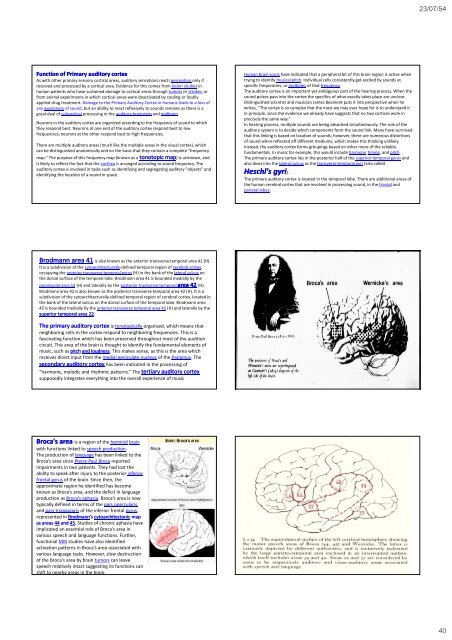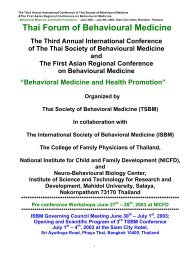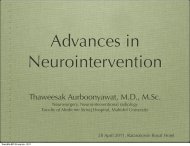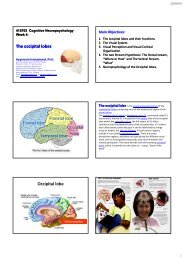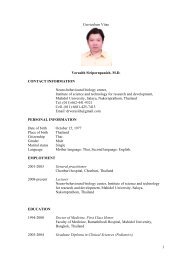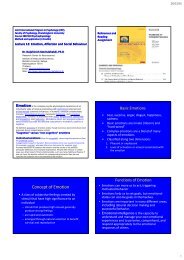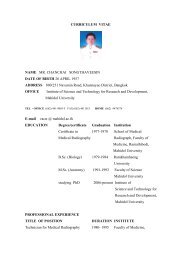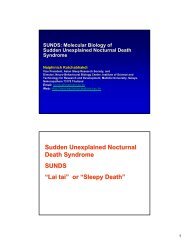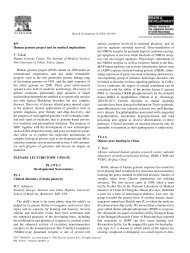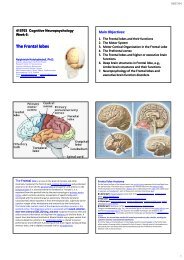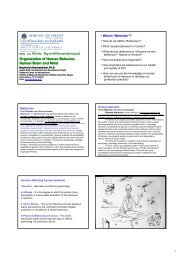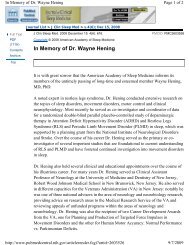Neurological Examination, clinical cases and neuropsychological ...
Neurological Examination, clinical cases and neuropsychological ...
Neurological Examination, clinical cases and neuropsychological ...
You also want an ePaper? Increase the reach of your titles
YUMPU automatically turns print PDFs into web optimized ePapers that Google loves.
23/07/54<br />
Function of Primary auditory cortex<br />
As with other primary sensory cortical areas, auditory sensations reach perception only if<br />
received <strong>and</strong> processed by a cortical area. Evidence for this comes from lesion studies in<br />
human patients who have sustained damage to cortical areas through tumors or strokes, or<br />
from animal experiments in which cortical areas were deactivated by cooling or locally<br />
applied drug treatment. Damage to the Primary Auditory Cortex in humans leads to a loss of<br />
any awareness of sound, but an ability to react reflexively to sounds remains as there is a<br />
great deal of subcortical processing in the auditory brainstem <strong>and</strong> midbrain.<br />
Neurons in the auditory cortex are organized according to the frequency of sound to which<br />
they respond best. Neurons at one end of the auditory cortex respond best to low<br />
frequencies; neurons at the other respond best to high frequencies.<br />
There are multiple auditory areas (much like the multiple areas in the visual cortex), which<br />
can be distinguished anatomically <strong>and</strong> on the basis that they contain a complete "frequency<br />
map." The purpose of this frequency map (known as a tonotopic map) is unknown, <strong>and</strong><br />
is likely to reflect the fact that the cochlea is arranged according to sound frequency. The<br />
auditory cortex is involved in tasks such as identifying <strong>and</strong> segregating auditory "objects" <strong>and</strong><br />
identifying the location of a sound in space.<br />
Human brain scans have indicated that a peripheral bit of this brain region is active when<br />
trying to identify musical pitch. Individual cells consistently get excited by sounds at<br />
specific frequencies, or multiples of that frequency.<br />
The auditory cortex is an important yet ambiguous part of the hearing process. When the<br />
sound pulses pass into the cortex the specifics of what exactly takes place are unclear.<br />
Distinguished scientist <strong>and</strong> musician James Beament puts it into perspective when he<br />
writes, “The cortex is so complex that the most we may ever hope for is to underst<strong>and</strong> it<br />
in principle, since the evidence we already have suggests that no two cortices work in<br />
precisely the same way."<br />
In hearing process, multiple sounds are being absorbed simultaneously. The role of the<br />
auditory system is to decide which components form the sound link. Many have surmised<br />
that this linking is based on location of sounds; however, there are numerous distortions<br />
i<br />
of sound when reflected off different mediums, which makes this thinking unlikely.<br />
Instead, the auditory cortex forms groupings based on other more of the reliable,<br />
fundamentals. In music for example, this would include harmony, timing, <strong>and</strong> pitch.<br />
The primary auditory cortex lies in the posterior half of the superior temporal gyrus <strong>and</strong><br />
also dives into the lateral sulcus as the transverse temporal gyri (also called<br />
Heschl's gyri).<br />
The primary auditory cortex is located in the temporal lobe. There are additional areas of<br />
the human cerebral cortex that are involved in processing sound, in the frontal <strong>and</strong><br />
parietal lobes.<br />
Brodmann area 41 is also known as the anterior transverse temporal area 41 (H).<br />
It is a subdivision of the cytoarchitecturally‐defined temporal region of cerebral cortex,<br />
occupying the anterior transverse temporal gyrus (H) in the bank of the lateral sulcus on<br />
the dorsal surface of the temporal lobe. Brodmann area 41 is bounded medially by the<br />
parainsular area 52 (H) <strong>and</strong> laterally by the posterior transverse temporal area 42 (H).<br />
Brodmann area 42 is also known as the posterior transverse temporal area 42 (H). It is a<br />
subdivision of the cytoarchitecturally‐defined temporal region of cerebral cortex, located in<br />
the bank of the lateral sulcus on the dorsal surface of the temporal lobe. Brodmann area<br />
42 is bounded medially by the anterior transverse temporal area 41 (H) <strong>and</strong> laterally by the<br />
superior temporal area 22.<br />
The primary auditory cortex is tonotopically organized, which means that<br />
neighboring cells in the cortex respond to neighboring frequencies. This is a<br />
fascinating function which has been preserved throughout most of the audition<br />
circuit. This area of the brain is thought to identify the fundamental elements of<br />
music, such as pitch <strong>and</strong> loudness. This makes sense, as this is the area which<br />
receives direct input from the medial geniculate nucleus of the thalamus. The<br />
secondary auditory cortex has been indicated in the processing of<br />
“harmonic, melodic <strong>and</strong> rhythmic patterns.” The tertiary auditory cortex<br />
supposedly integrates everything into the overall experience of music<br />
7/23/2011 NEUROPSYCHIATRY 238<br />
Broca's area is a region of the hominid brain<br />
with functions linked to speech production.<br />
The production of language has been linked to the<br />
Broca’s area since Pierre Paul Broca reported<br />
impairments in two patients. They had lost the<br />
ability to speak after injury to the posterior inferior<br />
frontal gyrus of the brain. Since then, the<br />
approximate region he identified has become<br />
known as Broca’s area, <strong>and</strong> the deficit in language<br />
production as Broca’s aphasia. Broca’s area is now<br />
typically defined in terms of the pars opercularis<br />
<strong>and</strong> pars triangularis of the inferior frontal gyrus,<br />
represented in Brodmann’s<br />
cytoarchitectonic map<br />
as areas 44 <strong>and</strong> 45. Studies of chronic aphasia have<br />
implicated an essential role of Broca’s area in<br />
various speech <strong>and</strong> language functions. Further,<br />
functional MRI studies have also identified<br />
activation patterns in Broca’s area associated with<br />
various language tasks. However, slow destruction<br />
of the Broca's area by brain tumors can leave<br />
speech relatively intact suggesting its functions can<br />
shift to nearby areas in the brain.<br />
7/23/2011 NEUROPSYCHIATRY 240<br />
40


